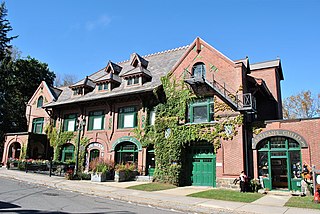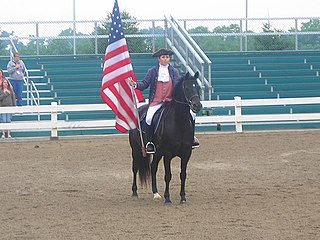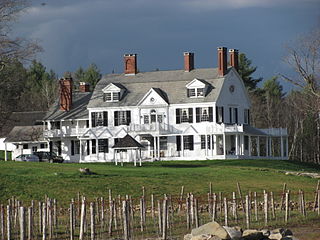
Norfolk is a town in Litchfield County, Connecticut, United States. The population was 1,588 at the 2020 census. The urban center of the town is the Norfolk census-designated place, with a population of 553 at the 2010 census.

The Morgan horse is one of the earliest horse breeds developed in the United States. Tracing back to the foundation sire Figure, later named Justin Morgan after his best-known owner, Morgans served many roles in 19th-century American history, being used as coach horses and for harness racing, as general riding animals, and as cavalry horses during the American Civil War on both sides of the conflict. Morgans have influenced other major American breeds, including the American Quarter Horse, Tennessee Walking Horse and the Standardbred. During the 19th and 20th centuries, they were exported to other countries, including England, where a Morgan stallion influenced the breeding of the Hackney horse. In 1907, the US Department of Agriculture established the US Morgan Horse Farm near Middlebury, Vermont for the purpose of perpetuating and improving the Morgan breed; the farm was later transferred to the University of Vermont.The first breed registry was established in 1909, and since then many organizations in the US, Europe and Oceania have developed. There were estimated to be over 175,000 Morgan horses worldwide in 2005.
Justin Morgan was a U.S. horse breeder and composer.

Lawrence Brainerd was an American businessman, abolitionist and United States Senator from Vermont. A longtime anti-slavery activist, after leaving the Jacksonians in the 1830s, Brainerd was active in the Whig, Liberty, and Free Soil parties, and was one of the organizers of the Republican Party when it was formed as the main anti-slavery party in the mid-1850s. Brainerd's longtime commitment to the cause of abolition was recognized in 1854, when opponents of slavery in the Vermont General Assembly chose him to fill a five-month vacancy in the United States Senate.

Joseph Battell was a publisher and philanthropist from Middlebury, Vermont. Battell is credited with preserving Vermont forest land including the land for Camel's Hump State Park. The Joseph Battell Wilderness in the Green Mountain National Forest bears his name.

Austin–Magie Farm and Mill District is a registered historic district near Oxford, Ohio, listed in the National Register on December 21, 1982. It contains 5 contributing buildings.

Figure was a small bay stallion owned by Justin Morgan; he became the foundation sire of the Morgan horse breed.

Brook Farm is a historic country estate farm at 4203 Twenty Mile Stream Road in Cavendish, Vermont. It includes one of the state's grandest Colonial Revival mansion houses, and surviving outbuildings of a model farm of the turn of the 20th century. It was listed on the National Register of Historic Places in 1993. The property is now home to the Brook Farm Vineyard.

Glen Dale Farm is a historic farm property at 1455 Cider Mill Road in Cornwall, Vermont. Its 3.5-acre (1.4 ha) property, which includes five contributing buildings, was listed as Glen Dale on the National Register of Historic Places in 2002. Farmed since the 1770s, the farm achieved prominence in the second half of the 19th century as one of the nation's top breeding sites of merino sheep.
The following is a timeline of the history of the city of Burlington, Vermont, USA

Morrill Hall is a campus building of the University of Vermont (UVM), which is located on the southeast corner of the "University Green" in Burlington, Vermont. The building was named after U.S. Senator, Justin Smith Morrill who authored the Morrill Land-Grant Acts of 1862 and 1890, which created the American Land-Grant universities and colleges. Senator Morrill also served as a trustee of the university from 1865 until 1898. The building was constructed during 1906–07 to serve as the home of the UVM Agriculture Department and the Agricultural Experiment Station. It was added to National Register of Historic Places as part of University Green Historic District on April 14, 1975. As of 2015, the building continues to house the College of Agriculture and Life Sciences and the UVM Agricultural Extension Service.

Mountain View Stock Farm, now known as Tylord Farm, is a historic estate farm on Vermont Route 22A in Benson, Vermont. Developed in the early 20th century around a late 18th-century farmhouse, the farm was renowned in the state for its breeding of Kentucky saddle horses and Chester White hogs. The farm complex also has architecturally distinctive Colonial Revival styling. The property was listed on the National Register of Historic Places in 1989.

The Ezekiel Emerson Farm, also known as Apple Hill Farm, is a historic farm property at 936 Brandon Mountain Road in Rochester, Vermont. Occupying 38 acres (15 ha), the farm includes a mid-19th century bank barn and a c. 1920-1940 milk barn that are both well-preserved examples of period agricultural buildings. The otherwise undistinguished house includes a fine example of a Late Victorian porch. The property was listed on the National Register of Historic Places in 2001.

The Wilcox-Cutts House is a historic house on Vermont Route 22A in Orwell, Vermont, USA. Its oldest portions date to 1789, but it is regarded as one of Vermont's finest examples of late Greek Revival architecture, the result of a major transformation in 1843. The house and accompanying farmland, also significant in the development of Morgan horse breeding in the state, was listed on the National Register of Historic Places in 1974.

The New Haven-Weybridge Rattling Bridge is a historic bridge spanning Otter Creek between the Vermont towns of Weybridge and New Haven. It connects Town Highway 7 in New Haven with Town Highway 11 in Weybridge. Built in 1908 by the American Bridge Company, it is a well-preserved example of a rivet-connected lattice truss bridge. It was listed on the National Register of Historic Places as Bridge 26 in 2006.

The Mad River Valley Rural Historic District encompasses a large rural landscape in northern Waitsfield and southern Moretown, Vermont. Encompassing some 1,400 acres (570 ha) of bottom lands on either side of the Mad River, the area has seen active agricultural use since the late 18th century, and retains a number of mid-19th century farmsteads. The district was listed on the National Register of Historic Places in 1994.

The Darling Estate Historic Estate encompasses an historic country estate of more than 2,000 acres (810 ha) on Darling Hill Road, straddling the town line between Burke and Lyndon, Vermont, USA. Built in the early 1900s for Elmer Darling, a locally-born New York hotelier, it was one of Vermont's largest such estates, featuring Burklyn Hall, one of its most opulent Colonial Revival houses, as well as numerous 19th-century farm properties. It was listed on the National Register of Historic Places in 2011.

The M.S. Whitcomb Farm is a historic farm property on United States Route 2 in Richmond, Vermont. Established in the 1850s as a horse farm, it has seen agricultural use in some form since then. Its most distinguishing feature is a large bank barn with a monitor roof, built in 1901. The property, now 170 acres (69 ha), was listed on the National Register of Historic Places in 1993.
Clinton Smith was an American architect. He designed many buildings in Middlebury and around Vermont.


















